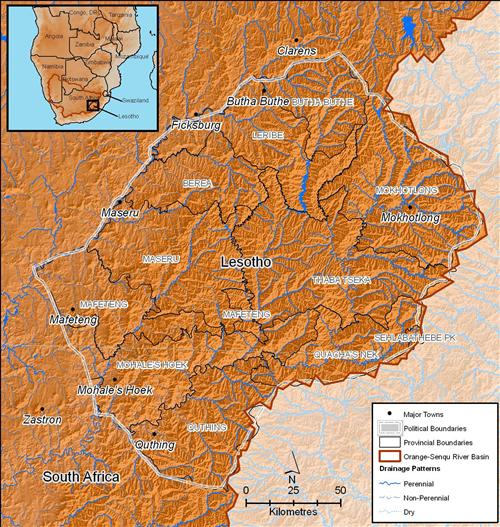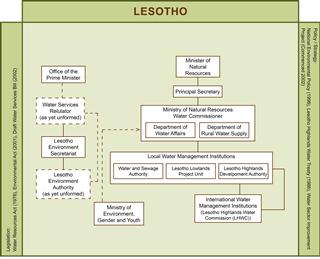The legislative framework for water resources management in Lesotho is the Water Resources Act of 1978. The Act stipulates the requirements for obtaining a permit for any water use other than for domestic purposes, and specifies that domestic water use takes priority over other uses. Under the Act, the Minister of Natural Resources declares certain areas protected for the purpose of development. Further legislation relevant to water resources is dispersed in several orders and acts administered by different departments.
The Water Act 2008 was recently enacted by the Parliament of Lesotho to 'provide for the management, protection, conservation development and sustainable utilisation of water resources'.
Policy and legislation in Lesotho are transitioning to a more integrated framework (ORASECOM 2007a). Aligning with Agenda 21, the Dublin Principles, the Helsenki Rules, SADC Declaration, SADC Regional Water Policy and the SADC Protocol on Shared Watercourses (Government of Lesotho 2007), the Water and Sanitation Policy was approved by the Ministry of Natural Resources in 2007 (Bildhaeuser 2010). The policy provides strategic guidelines for:
-
Sustainable water resources management adopting IWRM principles
-
Effective delivery of water supply and sanitation services
-
Measures for protection and conservation of water resources and associated ecosystems
-
Management and use of transboundary water resources with downstream countries in shared watercourses
-
Coordination among all sectors and stakeholders for IWRM
-
Institutional and regulatory framework of the water sector for implementation of IWRM
The Environment Act of 2001, although not currently enforced, also acts as a principle document affecting environmental management of water and land resources (ORASECOM 2007a). The National Environmental Policy 1998 provides the framework for water policy development in the country. The policy recognizes “periodic prolonged drought and scarcity of water for agriculture” and “pollution of land and water courses” in its preamble, and advocates providing access to portable water for all people (Government of Lesotho 2001).

Lesotho in relation to the Orange-Senqu River basin.
Source:Hatfield 2009
( click to enlarge )
The entire country of Lesotho falls within the borders of the Orange-Senqu River basin. As it operates major infrastructure projects jointly with South Africa, Lesotho’s policy framework is closely tied to South Africa’s—strongly influenced by the Lesotho Highlands Water Project (Kranz et al. 2005).
Institutional Responsibilities
The Office of the Commissioner of Water, within the Ministry of Natural Resources, is mandated to promote coordination of programs and activities within the water sector (Government of Lesotho 2007). The Commissioner is responsible for the Department of Water Affairs and Rural Water Supply (DRWS). Additionally, the Commissioner overseas two parastatals: the Lesotho Highlands Water Development Authority (LHDA) and the Water and Sewage Authority (WESA) (ORASECOM 2007j).
The organisation responsible for implementing the Water Act 1978 is the Department of Water Affairs (DWA) within the Ministry of Natural Resources. The DWA is responsible for general administration of the water sector, as well as for policy formulation and data collection. DRWS is mandated to supply water to rural communities in Lesotho, while WESA manages water supply to urban areas (ORASECOM 2007a).
The institutional arrangements pertaining to water management in Lesotho are presented in the diagram below.
 National laws and institutions of Lesotho. Source:Krantz et al. 2005; Lesotho Water and Sewage Authority 2006 ( click to enlarge ) |
Regulatory Framework for Transboundary Water Management
Transboundary water resources are addressed in Policy Statement 4 of the Water and Sanitation Policy which states the intention to:
“Manage trans-boundary water resources on the basis of Lesotho’s sovereignty in a way that ensures maximum benefits while taking cognisance of her obligations to downstream users under international law.” (Government of Lesotho 2007)
The strategies to achieve this objective include, promoting cooperation, adopting IWRM, and promoting a bilateral initiative for the development and implementation of an integrated planning framework for the Mohokare/Caledon River basin. Two of the five strategies promote knowledge management, including developing a monitoring system and a management information system for water resources.
Regulatory Framework for Disaster Management
Lesotho's Disaster Risk Management System has progressively improved with the enactment of the Disaster Management Act of 1996 and the Disaster Management Operations Manual (UNDP 2007). Nevertheless, emergency response remains the primary focus of current disaster management activties. Lesotho is increasingly facing serious challenges in food insecurity due to erratic rainfall, cyclical droughts, climate change, limited arable land, and weak capacities of national agencies to provide necessary social services. The United Nations Development Programme (UNDP) in particular, works with the Government of Lesotho to enhance capacity in disaster risk reduction (DRR). Some of it's efforts have included the development of a Draft DRR Policy; establishment of Disaster Management Teams at district and village levels; and, provision of training on disaster risk assessment and reduction (UNDP 2007).
Challenges
Although Lesotho appears to have developed a modern water management framework, the implementation of this structure is constrained by several factors (ORASECOM 2007a). The policy, legislative and institutional frameworks are still at initial stages of development and transformation into an integrated framework, and therefore are not fully operational. The technical capacity within Lesotho's government agencies to implement an IWRM framework is also limited, and the available capacity is mostly concentrated on local-level issues. This affects Lesotho's contribution to sustainable management of water resources at the basin-level, in corporation with neighboring countries.
Documents related to the national water laws in Lesotho can be viewed in the Document Library.
